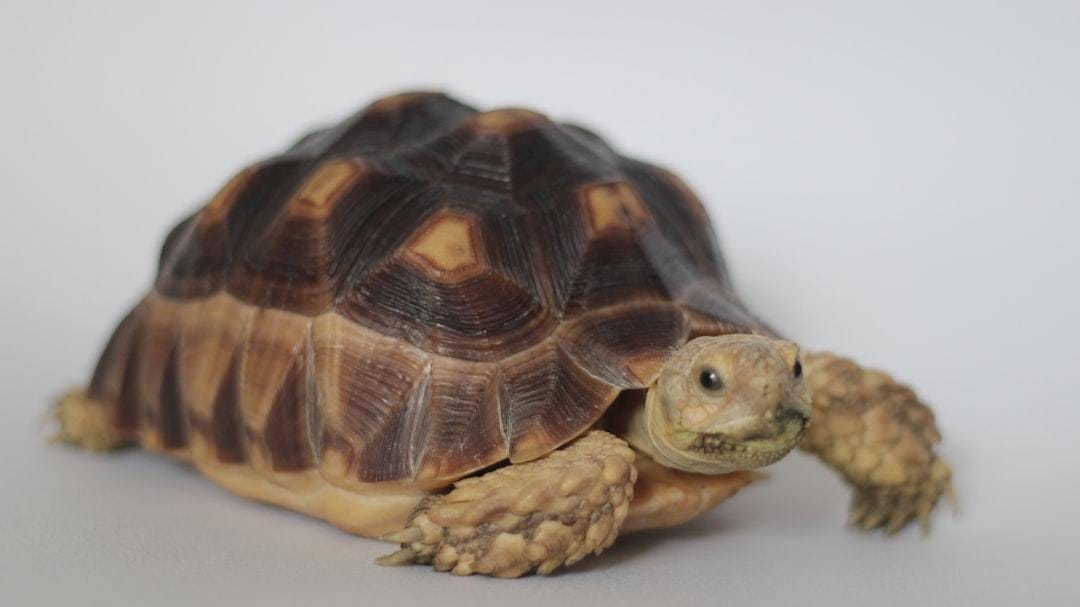Imagine a pet that’s as ancient as it is majestic yet challenging in ways you might not expect. That’s the sulcata tortoise for you. Delving into this piece, we uncover the allure and intricacies of these ancient beings, exploring everything from their distinctive habits to the critical conditions they require to thrive in the wild.
Let’s embark on a fashion journey, the perfect habitat for your sulcata tortoise, delving into crucial elements like optimal warmth and the right kind of light. You’ll also get the lowdown on crafting a diet that keeps them healthy and happy because nutrition plays a massive role in their well-being.
But it’s not all smooth sailing; we’ll tackle common health issues these pets face and how to prevent or manage them effectively. Finally, considering the advantages and disadvantages will offer a more vivid understanding of living with a sulcata tortoise, guiding your decision on whether they mesh well with your household dynamics.
Table Of Contents:
- Understanding Sulcata Tortoises as Pets
- Check Local Regulations
- Creating the Ideal Habitat for Your Sulcata Tortoise
- Sulcata Tortoise Diet and Nutrition
- Health Issues Common in Sulcata Tortoises
- Pros and Cons of Keeping a Sulcata Tortoise
- A Sulcata Tortoise Will Outlive You
 AI illustration of a pet Sulcata Tortoise
AI illustration of a pet Sulcata Tortoise
Understanding Sulcata Tortoises as Pets
If you’re thinking a sulcata tortoise, also known as African Spur or spurred tortoise, is just another slow-moving pet that doesn’t do much, think again. Welcoming these beings into your abode is akin to inviting the wild essence and intriguing character of the African plains, each with its unique disposition as vast and captivating as their original wilderness.
Sulcatas are not your average small turtle that can live happily in a tank; they grow to be quite large, requiring ample space to roam. Imagine having a living dinosaur who loves to dig and explore – that’s what keeping a sulcata tortoise feels like. PetMD accentuates their spacious demands, underscoring the necessity of vast outdoor habitats for these behemoths.
But it’s not all about size with these guys; their diet plays a crucial role too. They flourish on a diet rich in fibrous grasses, underscoring their deep-rooted connection to the parched landscapes of Africa from which they hail. Grasping this link empowers caretakers to enhance their care practices by closely replicating the animals’ native habitats.
Check Local Regulations
Welcome to the essential guide on keeping a sulcata tortoise as a pet. Before you decide to bring one of these majestic creatures into your home, it’s crucial to understand their care requirements and the legal responsibilities of owning such a unique pet. Additionally, given their long lifespan, planning for their care if they outlive you is an important consideration.
Legal Responsibilities of Owning a Sulcata Tortoise
Owning a sulcata tortoise comes with specific legal considerations that vary by location. Before acquiring one, it is imperative to check local wildlife regulations and obtain any necessary permits. In some areas, owning exotic pets like sulcatas may be restricted or require special documentation due to concerns about invasive species and ecological balance. A good starting point is visiting your state’s wildlife department website or contacting them directly for guidance.
The U.S. Fish & Wildlife Service website offers resources on federal laws regarding exotic pets, which can complement your local research.
Lifetime Commitment: Planning Ahead for Your Pet’s Future
- Lifespan: Sulcata tortoises are known for their longevity, often living 50 years or more in captivity. This remarkable lifespan means ownership is potentially a multi-generational commitment.
- Care Planning: Given the likelihood that your pet might outlive you, it’s prudent to have plans in place for its future care. This could include setting up legal arrangements through wills or trusts specifically designed for pet care, identifying potential caretakers among family or friends early on, and ensuring they are willing and able to take over when needed.
- Educational Resources: Thoroughly educating yourself about the needs of your sulcata tortoise ensures that you and future caregivers are well-prepared. Visit reputable sites like Tortoise Forum, where experienced owners share insights on proper habitat setup, dietary needs, and common health issues these reptiles face. This knowledge transfer is vital in securing ongoing quality care across generations.
Creating the Ideal Habitat for Your Sulcata Tortoise
To ensure the well-being and joy of your Sulcata tortoise, it’s vital to craft a living area that closely resembles their native African savannas. Crafting the perfect home environment is key to ensuring their well-being and joy.
Space Requirements
A sulcata tortoise needs room to roam. These creatures can become quite large as they grow, so starting with a spacious enclosure is key. Outdoor enclosures are preferred because they offer natural sunlight but ensure they’re secure to prevent escapes.
To learn more about outdoor housing and enclosure size options for your pet, visiting Tortoise Forum might give you some fresh ideas and practical advice from fellow tortoise enthusiasts.
Temperature and Lighting
Maintaining the right temperature and providing adequate UVB lighting are non-negotiables for sulcata tortoises. A basking area with temperatures around 95-100°F during the day is essential, along with cooler areas to retreat to. Nighttime temperatures should not drop below 70°F.
UVB lighting helps them metabolize calcium properly, which is vital for shell development and overall health. Without it, they’re at risk of metabolic bone disease—a common issue among captive reptiles.
For detailed guidance on setting up proper lighting, Reptiles Magazine offers excellent resources.
Check Amazon’s wide variety of sulcata tortoise habitat options.
Sulcata Tortoise Diet and Nutrition
Feeding your sulcata tortoise is more than tossing some greens into their habitat. It’s about balance, variety, and understanding their nutritional needs.
The Essentials of a Balanced Diet
A healthy diet for a sulcata consists mainly of grasses and hay. These fiber-rich foods mimic their natural grazing habits in the wild. But it doesn’t stop there; adding leafy greens like dandelion, kale, and collard provides necessary vitamins and minerals.
However, moderation is key with fruits due to their high sugar content, which can lead to health issues over time. Think of fruit as an occasional treat rather than a staple in their diet.
Hydration: A Key Component
Besides their regular diet, ensuring your tortoise stays hydrated is fundamentally important for its well-being. Sulcatas may not drink often, but ensuring daily access to fresh water is essential. Moreover, integrating water-laden veggies like cucumbers into their diet offers an alternative method for optimal hydration levels, without depending entirely on direct water intake. Having a water dish available with fresh water is a must.
Incorporating these dietary practices will not only keep your sulcata happy but also thriving for years to come.
Health Issues Common in Sulcata Tortoises
Sulcata tortoises are pretty hardy creatures, but like all pets, they can run into health issues. Being aware of potential health concerns can significantly impact their well-being.
Respiratory Infections
Ever heard a tortoise sneeze? Sometimes, what seems like a bit of dust tickling their nostrils could hint at something deeper. Respiratory infections are common in sulcatas kept in environments that are too cold or damp. Symptoms include wheezing, nasal discharge, and lethargy. Keeping their habitat warm and dry is key to prevention.
If you notice these signs, getting your shelled buddy checked by a vet familiar with reptiles is crucial for proper treatment.
Shell Problems
A healthy shell is vital for a tortoise’s survival; it’s their mobile home. Shell rot and pyramiding are two issues caused by poor diet or incorrect humidity levels. A balanced diet rich in calcium and vitamin D helps prevent these problems while maintaining the right humidity to keep their shells tough as nails.
Detailed care guides on pyramiding offer more insights into keeping your tortoise’s shell in top shape.
To avoid unexpected health costs, check out Pet Assure Mint.
Pros and Cons of Keeping a Sulcata Tortoise
Owning a sulcata tortoise is like having a living piece of prehistory in your backyard. But before you embark on this ancient pet-keeping journey, let’s weigh the ups and downs.
The Sunny Side: Pros
Sulcatas are gentle giants known for their docile nature, which makes them fantastic pets for families with space to spare. They’re also pretty low maintenance for feeding—grass hay and leafy greens will do the trick. Plus, they have an impressive lifespan, often becoming lifelong companions as they can live up to 70 years or more.
A Bit Cloudy: Cons
However, there’s no such thing as a free lunch—or in this case, an easy-to-care-for giant tortoise. These creatures need ample room to roam; we’re talking about an outdoor enclosure that could rival some city apartments in size. And while their diet might be simple, ensuring they get enough calcium can be tricky without proper research. Then there’s the matter of veterinary care specialized enough for exotic pets—it’s not always easy to find.
A Sulcata Tortoise Will Outlive You
Embarking on the sulcata tortoise care adventure, you’ve delved deep into their world. You now know these ancient creatures need more than just love.
First off, setting up their home is crucial; space and temperature can’t be afterthoughts. Then there’s diet—balance and hydration are key to keeping them thriving.
However, remember that this journey isn’t always a walk in the park. Health issues can arise, yet with vigilance, they’re manageable.
The decision to welcome a sulcata tortoise into your life? It’s big. But now you’re armed with knowledge—to make that choice informed and confident.
Adopting a pet of this kind involves fully accepting its wonders and the obstacles it presents. Embarking on this path, you’re in for an astonishing adventure!


Comments are closed.